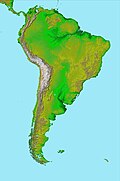| Chilean Iron Belt | |
|---|---|
| Stratigraphic range: Cretaceous ~ | |
| Type | Mining district |
| Location | |
| Coordinates | 27°21′59″S70°25′59″W / 27.366389°S 70.433056°W |
| Region | Atacama Region, Coquimbo Region |
| Country | Chile |
| Extent | Atacama Fault System |
Chilean Iron Belt (Chile) | |
The Chilean Iron Belt is a geological province rich in iron ore deposits in northern Chile. It extends as a north-south beld along the western part of the Chilean regions of Coquimbo and Atacama, chiefly between the cities of La Serena and Taltal. [1] [2] The belt follows much of the Atacama Fault System and is about 600 km long and 25 km broad. [2] [3]
Iron oxide-apatite, iron oxide copper gold ore deposits (IOCG) and manto-type copper and silver are the main types of deposits. [1] [2] Iron-apatite and IOCG are considered to have different origins. [4] Manto-type deposits are concentrated in the northern part of the belt and are chiefly emplaced on rocks of La Negra Formation. [1] The belt host also significant resources of cobalt which were deemed by 2017 to have the potential to be extracted as by-products of iron and copper mining along the belt. [5]
The ores of the Chilean Iron Belt formed in separate pulses in the Cretaceous period as result of magmatic and hydrothermal processes. [1] At least part of the iron oxide-apatite rock originated from molten iron in the form of lava, tephra. [3] and intrusions. [4] Thus iron oxide apatite magma cooled into rock variously from surface volcanoes to depths of 10 km over even more. [4] Various deposits are covered by continuous sheets alluvial sedmients that form plains on surface. [6]
Some geologists have speculated that a large meteorite impact in the Pacific during the Cretaceous period may have set in motion a series of tectonic changes that led to the formation the ores. [7]
Systematic survey of the iron ores of the belt for economic exploitation begun with civil engineer Carlos Vattier in the late 19th century [8] [9] and continued with Juan Brüggen who published a report on them in 1913. [10] [11] Mining engineer C. Linnemann took over government-commissioned studies at the recommendation of Brüggen and surveyed southern part of the belt in 1917 and 1918. [11] Various ore deposits of the belt were studied by Carlos Ruiz Fuller and co-workers for aspects of their economic geology in the mid-1940s publishing a report in 1946. [12] Studies on ore genesis in the iron belt were published by Ruiz Fuller and his co-workers in 1967 in Spanish and in 1968 in English. [13]



